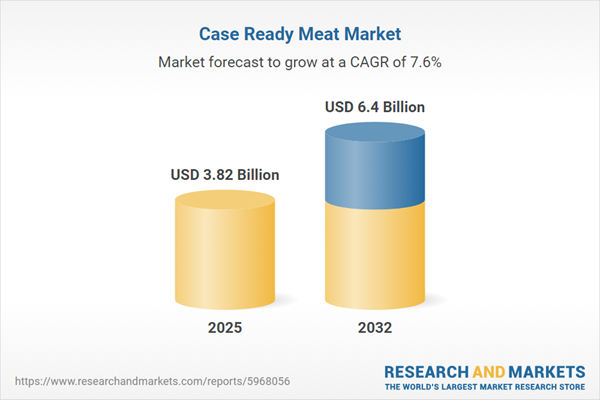Speak directly to the analyst to clarify any post sales queries you may have.
The Case Ready Meat Market requires senior executives to balance changing consumer preferences, increasingly rigorous regulations, and a focus on operational efficiency. Adopting technology, building resilient supply chains, and driving sustainable practices are now strategic imperatives for industry leadership.
Market Snapshot: Case Ready Meat Market
The Case Ready Meat Market is showing robust growth, fueled by strong demand from retail, food service, and institutional channels. Competitive differentiation is driven by a focus on product quality, accessibility, and consistent safety standards. Automation plays a pivotal role in reducing operational challenges, enhancing supply network reliability and uniformity. Regulatory complexities and a consumer focus on transparency have increased investments in digital traceability and related technologies. Technology integration supports risk management and compliance, enabling organizations to adapt to evolving market conditions and meet increased auditing standards across varied regions.
Scope & Segmentation: Case Ready Meat Market
- Product Types: Cooked, fresh, frozen, and marinated meats serve diverse consumption needs across retail and food service, supporting broader brand portfolios.
- Animal Types: Beef, lamb, pork, and poultry products underpin access to both mature and developing markets, responding to diverse culinary patterns.
- Distribution Channels: Convenience stores, supermarkets, hypermarkets, online vendors, food service platforms, and specialty outlets enable tailored market strategies by geography and demographic segment.
- End Users: Food service operators, institutional buyers, and households shape packaging, handling, and service approaches, driving new product development and operational agility.
- Packaging Types: Bulk packs, modified atmosphere, overwrapped trays, vacuum-sealed formats, and smart packaging technologies enhance shelf life, freshness, and product traceability.
- Regional Coverage: The Americas, Europe, Middle East and Africa, and Asia-Pacific segments demand customized supply approaches due to local regulatory frameworks and sustainability pressures.
- Leading Companies: JBS S.A., Tyson Foods, Cargill, WH Group, BRF S.A., Marfrig Global Foods, NH Foods, Hormel Foods, Danish Crown, and Vion Food Group advance sector practices and traceability.
- Technologies Profiled: Robotics, machine vision, artificial intelligence for inspection, digital traceability tools, and advanced packaging increase efficiency and support compliance across the supply chain.
Key Takeaways for Senior Leaders
- Scale automation to redeploy labor from repetitive tasks and align operational focus with emerging business and consumer priorities.
- Extend ready-to-cook product portfolios and enhance packaging and labeling to support transparency and brand consistency.
- Align procurement and operations with sustainability initiatives such as recyclable materials and tracking of environmental performance to meet stakeholder and regulatory expectations.
- Pursue supply chain models flexible enough to meet regionally specific regulations and fluctuating market needs efficiently.
- Deepen collaboration with packaging experts and prioritize regional sourcing to build a more resilient supply chain and reduce the impact of external disruptions.
Tariff Impact
Recent tariff adjustments are reshaping input costs and influencing procurement patterns for global organizations. Senior executives can offset increased volatility by emphasizing local sourcing, establishing strong supplier networks in priority regions, and broadening supply portfolios to limit exposure to regulatory shifts.
Methodology & Data Sources
This Case Ready Meat Market analysis integrates senior executive interviews, industry-specific surveys, and independent expert insights. All findings are validated through a multi-step process to align with industry quality standards and provide maximum relevance to leadership teams.
Case Ready Meat Market: Why This Report Matters
- Empowers leaders to advance automation and packaging, while navigating dynamic regulatory environments with confidence.
- Provides actionable insights for procurement and operations teams to improve risk management, increase supply chain agility, and enhance market response capabilities.
- Facilitates process improvements that strengthen stakeholder value and reinforce competitive positioning within the Case Ready Meat Market.
Conclusion
Maintaining competitiveness in the Case Ready Meat Market depends on proactive technology adoption, a focus on sustainability, and a thorough understanding of regional dynamics. Strategic partnerships and forward-looking planning will help organizations address change and drive sustainable growth.
Additional Product Information:
- Purchase of this report includes 1 year online access with quarterly updates.
- This report can be updated on request. Please contact our Customer Experience team using the Ask a Question widget on our website.
Table of Contents
3. Executive Summary
4. Market Overview
7. Cumulative Impact of Artificial Intelligence 2025
Companies Mentioned
The companies profiled in this Case Ready Meat market report include:- JBS S.A.
- Tyson Foods, Inc.
- Cargill, Inc.
- WH Group Ltd.
- BRF S.A.
- Marfrig Global Foods S.A.
- NH Foods Ltd.
- Hormel Foods Corporation
- Danish Crown A.m.b.A.
- Vion Food Group B.V.
Table Information
| Report Attribute | Details |
|---|---|
| No. of Pages | 189 |
| Published | October 2025 |
| Forecast Period | 2025 - 2032 |
| Estimated Market Value ( USD | $ 3.82 Billion |
| Forecasted Market Value ( USD | $ 6.4 Billion |
| Compound Annual Growth Rate | 7.6% |
| Regions Covered | Global |
| No. of Companies Mentioned | 11 |









